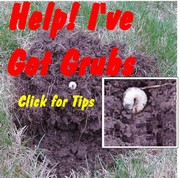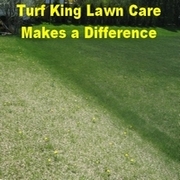Date: Monday Jan. 3, 2011 5:04 PM PT
An invasion is underway in Vancouver's wealthiest neighbourhood, where the tiny European chafer beetle is causing thousands of dollars in lawn damage.
The disaster is unfolding on the manicured lawns of Shaughnessy, where skunks, raccoons and crows are ripping up the grass to get to the beetle larvae buried below.
"We're talking multi-million dollar properties where people spend thousands of dollars a year on their landscaping, and some of them with rather large lawns. It's not a problem that's going to go away in the foreseeable future," Paul Corbett of Cutting Edge Lawn Care told CTV News.
The beetle infestation has been a problem in New Westminster and Burnaby since 2001. It's believed that an infected shipment of soil arrived from Ontario, and Corbett says the beetle is now migrating west toward the University of B.C.
"The beetles, when they hatch, fly towards the setting sun. They always hatch at night or in the evening, and they always just tend to fly toward the sunset," he said.
Homeowners like Annie Jangze are trying to stop hungry animals from pawing at their lawns by laying down chicken wire.
"I tried to scare a raccoon off, and I brought a hockey stick and I said, ‘Hey, you' and he just looked at me", she said.
"I want to enjoy my green."
Some residents on Wiltshire Street are removing their lawns altogether.
Corbett says the cold weather won't kill the beetles, and there is nothing that homeowners can do until the summer, when the insects lay their eggs.
There are only two treatment options: microscopic worms called nematodes that attack the eggs, or Merit, an insecticide that is only allowed in certain municipalities.
Corbett suggests that neighbours get together and agree on a treatment plan so that the beetles can be eradicated.
With a report from CTV British Columbia's Lisa Rossington
Q: My mother-in-law and I have different theories about lawn care. She is of the generation where you make regular use of commercial pesticides and fertilizers to get the "golf course" look to a lawn.
I prefer a natural, environmentally safer approach to lawn care. For the past three seasons, I have been using a mulching mower and have not bagged grass in that time. I use all-organic fertilizer. In season, I cut high at 3½ inches, and in the fall, I spread leaves from various trees on the lawn in a light layer and mulch-mow all of them in as well.
My mother-in-law, however, believes that grass and leaf clippings from the mulching mower simply "lie in clumps" on the top of the lawn, preventing water and other lawn nutrients from getting into the soil. She believes the leaves and grass don't disintegrate and create "bumps" in the lawn, which she believes makes it difficult for her to walk.
Who is right? If I am right, she bakes me three dozen of my favorite cookies. If she's right, I will take her to dinner at a restaurant of her choice.
A: You want me to get in the middle of a mother-in-law dispute? This could be trouble...
I have to go with you on this one, though. Your regimen is solid from beginning to end, and I'll bet your results back that up.
If your grass clips and mulched leaves just sat there, you'd see them. Or at least you'd be able to rake up a clump and take a closer look to see what might be causing any "bumps".
Nature does a quick and effective job of breaking down organic matter -- especially small pieces like grass clips and leaf fragments. These two also add up to the perfect blend of nitrogen and carbon that's ideal for composting.
Come spring, these materials will be composted into excellent nutrients and organic matter that will help lawn growth. Penn State's research found that letting the clips lie like you're doing contains the equivalent nutrition to one fertilizer application per year.
Much research also has found that grass clips and leaf fragments are not a significant cause of thatch. Thatch is that thick, spongy layer that can build up at the lawn surface and impede rain and nutrient use. The main component of thatch is dead grass roots, which usually happens from excess fertilization, cutting too low and shallow, frequent irrigation.
Healthy lawn soil is teeming with life, and it's those bio-organisms that help break down organic matter. When you kill off that life with regular applications of insecticides, herbicides and fungicides, you're slowing a lawn's ability to break down dead organic matter. In other words, those high-input commercial programs are much more likely to contribute to thatch than the system you're using.
As for bumps in the lawn, a variety of other factors are usually behind those. Soil-tunneling bugs called cicada-killers are a big one that I see, but bumps also come from various lawn fungi (especially "puffballs"), tree roots (roots can easily extend out twice as far as the branch canopy), earthworm activity and the dropping of acorns, sweetgum balls and assorted other tree fruits.
If your mother-in-law notices bumps, a good way to solve the problem is to dig down and see what they're made of. I don't think you're going to find any little clumps of grass and leaves.
Enjoy your cookies... but stay on mother-in-law's good side by taking her out to dinner, too.George WeigelMowed leaves like these on the lawn won't lead to bumpiness.
http://turfkinghamilton.blogspot.com/
http://kingofgreen.blogspot.com/
http://twitter.com/#!/turfkingofgreen
http://www.facebook.com/pages/Turf-King-Hamilton/110675539001874
From: http://blog.pennlive.com/gardening/2010/12/lawns_and_mothers-in-law.html#comments

It's summer, it's hot, it's humid, it's been dry.
What should your lawn look like?
If you care, what do you do to help your lawn look green and healthy?
Does your lawn care provider use products to help cope with summer's stresses?
Our high potassium fertilizer is formulated to help your lawn be better able to handle the heat and drought of the summer.
We recommend regular, deep watering. We recommend a mowing height of 3".
Ask us why.
Thanks to Larry who sent this photo of his lawn.
http://turfkinghamilton.blogspot.com/
http://kingofgreen.blogspot.com/
http://twitter.com/#!/turfkingofgreen
http://www.facebook.com/pages/Turf-King-Hamilton/110675539001874











